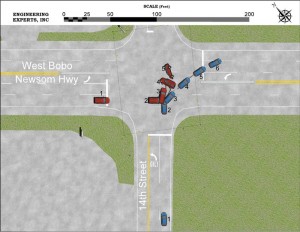Accident reconstruction is defined as the scientific process of investigating, analyzing, and drawing conclusions about the causes and events during a vehicle collision. As accident reconstructionists, we conduct in-depth collision analysis. Then we use the sequence of events to identify the collision causation and contributing factors in different types of collisions. This often includes the role of the drivers, vehicles, roadway and the environment. The laws of physics and engineering principles (such as the conservation of linear momentum, work-energy methods, and kinematics) are the basis for these analyses. Many accident reconstructionists use simplifications or make assumptions that affect the accuracy of their analysis. We assist our clients both by rendering accurate and defensible expert opinions, and by analyzing opposing expert’s methods and the accuracy of their results.
To more accurately determine speed from tiremarks, we have developed tools (based on accepted accident reconstruction principles) that precisely take into account slope of the road, the condition of each tire (locked, free, driven, delaminated, flat, wet, etc.), the weight distribution on each tire, the orientation of each tire relative to its path, etc. We apply these tools based on our extensive education in the principles of physics and dynamics to accurately determine the motions and speed of the vehicle along its path.
When vehicles collide with other objects (vehicles, telephone poles, trees, etc.) the components of the vehicle are deformed or “crushed”. We take into account the varying crush at different heights, the difference in crush stiffness of components in the vehicle, the effect of multiple impacts, etc., in determining speed loss that occurs during impact.
Reaction time can be an important factor in determining whether a driver acted appropriately in an accident. We use tools that provide the appropriate reaction times for each specific situation (day or night, number of stimuli, path intrusion, etc.) so it is defensible.
The braking systems on heavy trucks are quite different than those on cars and light trucks. We take into account brake energization (time for air brakes to become fully effective and the amount of braking that takes place as they are becoming fully effective), S-cam brake adjustment (the amount of braking depends on the brake stroke for each set of wheels), the realistic friction coefficient for truck tires (which is considerably less than for passenger tires), etc. to derive the speed of a semi from the skid marks left during an accident.
We apply these accident reconstruction techniques and principles to all types of vehicle accidents (such as ATVs, go-carts, bicycles, motorcycles, postal vans, trailers, emergency vehicles, etc.)

